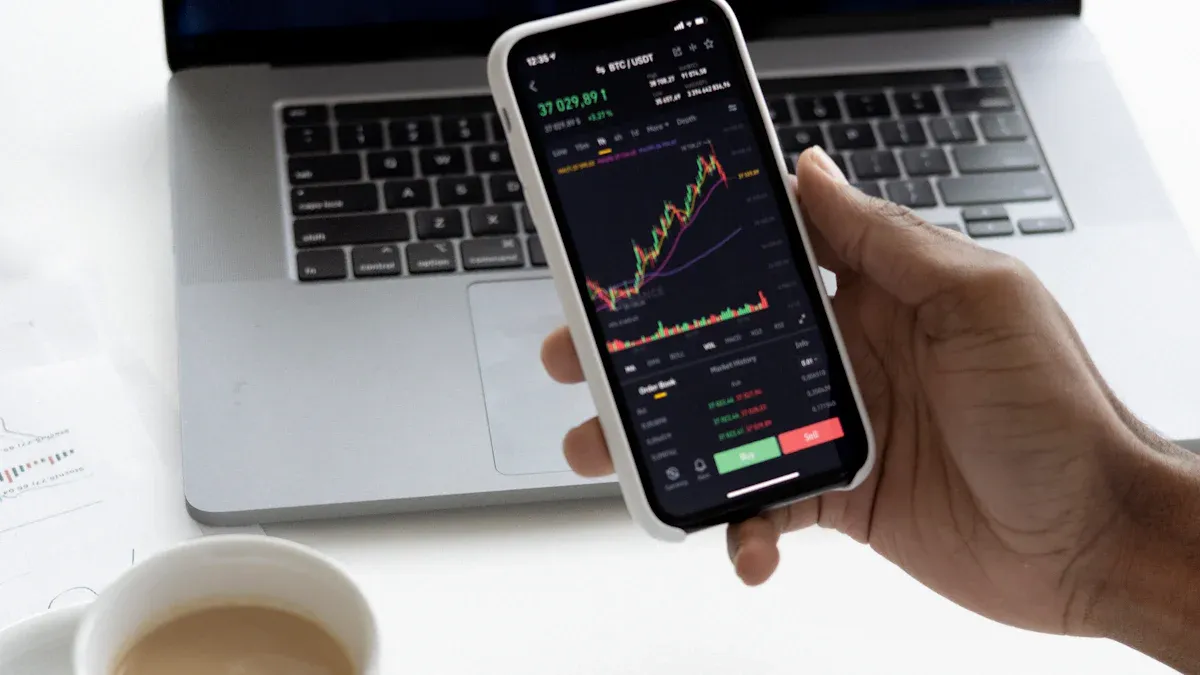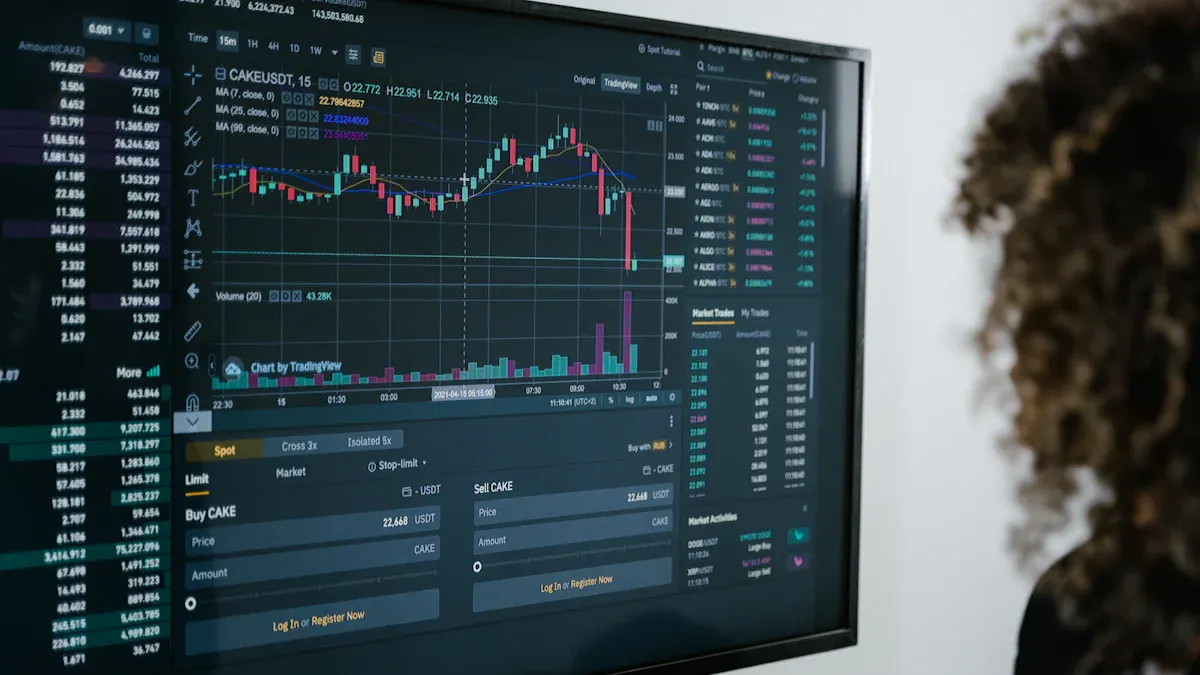- EasyCard
- Trade
- Help
- Announcement
- Academy
- SWIFT Code
- Iban Number
- Referral
- Customer Service
- Blog
- Creator
Stablecoin Remittance Fee Comparison: Ultimate Guide to Choosing USDT Transfer Platforms

Image Source: pexels
We get straight to the point and point out a clear money-saving path for you. Overall, buying via P2P on OKX platform and withdrawing on TRC-20 network is the lowest-cost solution for most users currently.
Using stablecoin USDT for global transfers effectively avoids market price fluctuations. Its cost is also far lower than traditional bank wires, providing a more efficient choice.
Key Takeaways
- Buying USDT via P2P trading and withdrawing on TRC-20 network is the best money-saving method.
- For small-amount remittance, choose OKX or Binance with lower withdrawal fees.
- For large-amount remittance, choose major platforms like Binance or OKX for greater security.
- Before transferring, confirm the network supported by the recipient and choose the lowest-fee network.
- Batch remittance saves fees since you pay the network fee only once.
Cost of Acquiring USDT: Starting from Deposit Methods
Before starting the transfer, you first need to obtain USDT. The way you acquire USDT directly determines your initial cost. Below, we break down three mainstream deposit methods to help you save from the first step.
P2P Trading: Lowest-Cost Mainstream Choice
P2P (Peer-to-Peer) trading allows you to buy stablecoin USDT directly from another user. The trading platform acts as an escrow, locking the seller’s coins until you pay and confirm, then transferring them to you.
The main cost of this method is a slight “premium,” where your purchase price is slightly higher than the real-time market price, but this is usually far lower than handling fees of other methods.
Beginner Tip Platforms like Binance P2P and KuCoin P2P are very suitable for beginners. They provide strong security features, such as:
- Escrow Service: Ensures transaction fund safety.
- Mandatory KYC Protocol: Reduces fraud risk.
- User Feedback and Rating System: Helps you choose reliable counterparts.
- 24/7 Customer Support: Solves issues anytime.
Credit Card Purchase: Convenient but Expensive Option
If you prioritize ultimate speed and convenience, using a credit or debit card is the fastest method. You just enter card details and complete the purchase in minutes.
However, the price of convenience is high fees. These are usually over 2% and may include platform fees plus extra bank charges.
| Platform | Payment Method | Fee |
|---|---|---|
| Binance | Credit/Debit Card | 2.00% |
| Crypto.com | Credit Card | Not specified |
| Coinbase | Credit Card | No information provided |
For remittance, 2% initial cost is quite high, so we generally do not recommend this method.
Bank Transfer: Efficient Path for Specific Platforms
Purchasing USDT directly via bank transfer is a lower-fee approach, but not all mainstream platforms support it. This method is more suitable for larger amounts.
Some platforms specializing in this, such as Swapped.com, allow users to buy USDT via bank transfer with “extremely low fees.” After payment confirmation, USDT is sent immediately to your wallet. When choosing such platforms, confirm if they support your region’s bank accounts (e.g., mainland China or Hong Kong).
Core Fee Comparison for Stablecoin USDT Remittance

Image Source: pexels
After obtaining USDT via P2P or other methods, the real remittance cost begins. This part mainly consists of two: platform trading fees (if you need to trade within the platform) and withdrawal fees. Understanding the differences is key to locking in the lowest total cost.
Platform Trading Fee Comparison
If you buy via P2P, usually no trading fees are involved as it’s direct user-to-user. But if you deposit one currency (e.g., USD) and buy USDT on the spot market, you pay trading fees.
Trading fees are divided into two types:
- Maker (Limit Order): You set a price and wait for others to fill. This provides liquidity, so rates are usually lower.
- Taker (Market Order): You take the best current market price immediately, removing liquidity, so rates are slightly higher.
For ordinary users, mainstream platform rate differences are small but still worth noting.
Mainstream Platforms Spot Trading Fees for Non-VIP Users
| Exchange | Maker Fee (Non-VIP) | Taker Fee (Non-VIP) |
|---|---|---|
| Binance | 0.1% | 0.1% |
| OKX | 0.08% | 0.1% |
| HTX | 0.2% | 0.2% |
| Biyapay | 0.1% | 0.1% |
Money-Saving Tip 💡 As shown, OKX offers lower Maker fees for ordinary users. If not in a hurry, use limit orders to save costs. Binance allows using BNB to pay fees for 25% discount, reducing to 0.075%.
If you trade frequently or with large volumes, platform VIP programs save significantly. Higher volume means higher VIP level and lower fees. For example, on OKX, VIP 1 cuts spot fees nearly in half.
Cross-Network Withdrawal Fee Comparison
Withdrawal fee is the fixed charge when transferring USDT from the platform to an external wallet. This is independent of transfer amount and depends on the chosen blockchain network.
This is where costs differ most in remittance.
- ERC-20 (Ethereum Network): Oldest and most universal but extremely high fees, usually 5-20 USDT, higher during congestion.
- TRC-20 (Tron Network): Currently most popular for USDT transfers, very low fees, usually fixed at 1 USDT.
- BEP-20 (BSC Network): Binance Smart Chain, similarly low, usually under 1 USDT.
- Polygon, Solana, etc.: Also low-fee but less widespread than TRC-20.
Clear Conclusion: For USDT remittance, prioritize TRC-20 network to minimize costs.
The table below compares approximate withdrawal fees on major networks across platforms. Note these adjust dynamically with network conditions; confirm on the platform withdrawal page before operating.
USDT Withdrawal Network Fee Comparison Across Platforms (Example)
| Platform | TRC-20 Network Fee | ERC-20 Network Fee | BEP-20 (BSC) Network Fee |
|---|---|---|---|
| Binance | Approx. 1 USDT | Approx. 5-15 USDT | Approx. 0.3 USDT |
| OKX | Approx. 1 USDT | Approx. 5-15 USDT | Approx. 0.8 USDT |
| HTX | Approx. 1.2 USDT | Approx. 5-15 USDT | Approx. 1 USDT |
| Biyapay | Approx. 1 USDT | Approx. 5-15 USDT | Not supported |
Comprehensive Cost Calculation Example
Now, simulate a real scenario for intuitive cost differences.
Scenario: You plan to buy 1000 USDT via P2P and send it to an overseas friend via TRC-20.
Assumptions:
- P2P market purchase with 0.1% slight premium.
- All platforms use TRC-20 for withdrawal.
Calculate total costs on different platforms:
Total Cost = P2P Purchase Premium Cost + Platform Withdrawal Fee
- On OKX:
- P2P Purchase Cost:
1000 USDT * 0.1% = 1 USDT - TRC-20 Withdrawal Fee:
Approx. 1 USDT - Total Cost: Approx. 2 USDT
- P2P Purchase Cost:
- On Binance:
- P2P Purchase Cost:
1000 USDT * 0.1% = 1 USDT - TRC-20 Withdrawal Fee:
Approx. 1 USDT - Total Cost: Approx. 2 USDT
- P2P Purchase Cost:
- On Biyapay:
- P2P Purchase Cost:
1000 USDT * 0.1% = 1 USDT - TRC-20 Withdrawal Fee:
Approx. 1 USDT - Total Cost: Approx. 2 USDT
- P2P Purchase Cost:
From this example, when using P2P deposit and TRC-20 withdrawal, final cost differences among mainstream platforms are very small. For small remittances, total costs are basically around 2 USDT, far below traditional bank wires’ tens of USD. This again proves our opening conclusion: P2P deposit + TRC-20 network withdrawal is the highest value path.
Scenario-Based Selection: Your Best Remittance Platform
We have understood cost components, but the “best” platform is not fixed. Your remittance amount, frequency, and specific needs determine the most suitable. Below, we break down three typical scenarios to help you make the wisest choice. Choosing the right platform and strategy effectively manages your stablecoin USDT assets.
Small-Amount High-Frequency Remittance Scenario
If you need frequent small transfers, such as paying service fees or sending living expenses to family/friends, your primary goal is reducing fixed costs per operation.
In this scenario, the core strategy is choosing platforms and networks with the lowest withdrawal fees.
- Focus: Fixed withdrawal fees.
- Best Network: TRC-20 or BEP-20.
- Platform Choices:
- OKX: TRC-20 withdrawal usually 1 USDT, extremely high value.
- Binance: TRC-20 competitive, BEP-20 even lower (approx. 0.3 USDT); excellent if recipient supports.
- Biyapay: Standard 1 USDT withdrawal, simple and direct, suitable for small high-frequency users.
Network Choice Critical Why emphasize network? Data shows TRC-20 not only low fee but far faster than traditional ERC-20. High-frequency cannot afford ERC-20’s high fees and long waits.
- TRON (TRC-20): Transaction fee usually under $0.01, confirmation in seconds.
- Ethereum (ERC-20): Fees during busy times up to $5 - $20, confirmation minutes or longer.
For users with higher needs, some platforms offer internal transfer zero fees. For example, if you and recipient are both on Cryptomus, USDT transfers between you waive all fees, minimizing costs.
Large-Amount Low-Frequency Remittance Scenario
When handling large funds (e.g., tens of thousands USDT or more), focus shifts from a few dollars fees to platform security, reliability, and fund protection. Safety is always first.
- Focus: Platform security, compliance, fund insurance, withdrawal limits.
- Core Strategy: Choose reputable, well-secured major platforms and seek extra asset protection.
Important Reminder: USDT Has No Government Deposit Insurance Recognize that crypto assets are unlike bank deposits. USDT is not protected by FDIC or similar. If platform or issuer faces extreme distress, your assets may be at risk.
Thus, for large transfers, actively manage risk:
- Choose Top Platforms: Prioritize Binance, OKX with long market validation, strong security teams, vast user base. They have enterprise-grade infrastructure like HSM and MPC for private keys.
- Enable All Security Settings: Must enable withdrawal address whitelisting to prevent hackers from transferring to their addresses after account theft. Carefully verify every transaction’s address and network; blockchain transactions are irreversible.
- Consider Professional Custody and Insurance: For institutions or ultra-high-net-worth, use professional digital asset custody. Though costlier, they provide higher security.
Crypto Asset Insurance and Custody Overview
| Service Name | Insurance/Service Type | Target Users | Notes |
|---|---|---|---|
| BitGo Custody | Custody & Insurance | Institutions, Funds | Up to $250M digital asset insurance, regulated custody. |
| Chainproof | Smart Contract Insurance | Enterprises, Large Protocols | Regulated policies focusing on code risks. |
| Nexus Mutual | Protocol & Depeg Insurance | Advanced DeFi Users, DAOs | Community-driven risk pool for on-chain coverage. |
| Gemini Custody | Custody & Insurance | Institutional Investors | Cold/hot wallet insurance, no FDIC/SIPC. |
For most individual large users, practical approach: Spread funds across 2-3 top platforms and use non-custodial wallets (you control private keys) for final storage to minimize single-platform risk. For example, remit from Hong Kong licensed bank to compliant platform, buy USDT, then transfer to your hardware wallet.
Specific Network Preference Scenario
Sometimes, choice is not yours but the recipient’s due to technical limits or preference, accepting only specific networks (e.g., Polygon, Solana, Avalanche) USDT.
- Focus: Whether platform supports required network and its withdrawal fee.
- Core Strategy: Before transfer, search and compare target network withdrawal fees on candidate platforms.
In this case, need a platform with rich network support.
- Confirm Network: Triple-confirm accurate receiving network and address with recipient. Wrong network causes permanent loss.
- Query Fees: Log into usual platforms, go to “Withdraw,” select USDT, view fees for different networks. Fees change real-time; confirm before operating.
- Choose Platform: Binance usually advantages here with vast blockchain support. Even smaller networks likely available, providing great flexibility.
In summary, when network is specified, your task is to find a reasonable-fee, trustworthy platform supporting it.
Universal Money-Saving Tips: Reduce USDT Transfer Costs

Image Source: pexels
After mastering platform and scenario selection, use universal tips to further compress USDT remittance costs. These simple effective methods save every unnecessary expense.
Prioritize Low-Fee Blockchain Networks
We emphasize again: choosing the right blockchain network is the most direct cost reduction. Besides mainstream TRC-20, other excellent low-fee options exist.
Low-Fee Network Comparison
- BEP-20 (BSC Network): Designed for high-speed transactions. Fee usually only 0.053 USD, confirmation in seconds. Excellent cost-effective if recipient supports.
- Polygon Network: Fees even lower, usually cents. Average confirmation 2-5 seconds, near-instant.
During withdrawal, spend a few seconds comparing network fees on the platform page to easily select the cheapest current path.
Leverage Platform VIP Programs and Promotions
If you trade frequently or with large volumes, platform VIP programs offer significant fee discounts.
Becoming VIP usually via huge trading volume or holding specified asset amounts. For example, on OKX, holding $100,000 assets qualifies for VIP 1. The table shows OKX VIP requirements based on volume.
OKX VIP Level Requirements (30-Day Trading Volume)
| VIP Level | Spot Volume (USD) | Futures Volume (USD) |
|---|---|---|
| VIP 1 | ≥ 5 Million | ≥ 50 Million |
| VIP 2 | ≥ 10 Million | ≥ 100 Million |
| VIP 3 | ≥ 20 Million | ≥ 200 Million |
For ordinary users, always watch platform promotions. Many exchanges launch limited-time zero withdrawal fees, trading rebates, or registration bonuses to attract users. For example, MEXC offered spot 0% maker fees, some give new users USDT bonuses.
Batch Remittance to Dilute Fixed Costs
If paying small amounts to multiple addresses, e.g., team salaries or multiple suppliers, do not transfer one by one. Use “batch remittance” function.
The principle is simple: merge multiple transfers into one transaction. Pay fixed network fee once instead of per transfer. For example, merging 10 payments originally costing 10×1 USDT now costs only 1 USDT total. This greatly reduces average cost per payment.
Many third-party tools like Cwallet, OptriTool provide easy batch payment solutions to automate, saving time and money.
We summarize core USDT remittance strategies. For most users, combining OKX zero-fee P2P deposit and TRC-20 is currently highest value. For high-volume users, focus on Binance VIP rate advantages.
We made this quick-reference table for fast decisions:
| Platform | Key Fees | Applicable Scenarios |
|---|---|---|
| OKX | Zero-Fee P2P + Approx. 1 USDT Withdrawal | Small-amount, high-frequency remittance, ultimate value |
| Binance | VIP Rate Discounts + Approx. 1 USDT Withdrawal | Large-amount, high-frequency trading, leverage level advantages |
Finally Remember: While pursuing low fees, safety is always first. Top platforms like OKX with AAA security rating and ISO certification provide stronger fund protection. Your final decision should balance fees and platform security.
FAQ
What Are the Core Differences Between OKX and Binance (Binance) for Remittance?
Think of it this way: OKX offers highly cost-effective solutions for ordinary users, especially small remittances. Binance provides VIP rate advantages for large traders. Your remittance amount and frequency determine which suits you.
What Happens If I Choose the Wrong Network (e.g., Send TRC-20 Coins to ERC-20 Address)?
Your Funds Will Likely Be Permanently Lost.
Each blockchain network is independent. You must ensure withdrawal network exactly matches receiving address network. Triple-confirm before operating.
Is USDT Remittance Completely Anonymous?
No, it is not completely anonymous. Understand two points:
- All transaction records are publicly queryable on the blockchain.
- Mainstream platforms require identity verification (KYC), linking your identity to your account.
*This article is provided for general information purposes and does not constitute legal, tax or other professional advice from BiyaPay or its subsidiaries and its affiliates, and it is not intended as a substitute for obtaining advice from a financial advisor or any other professional.
We make no representations, warranties or warranties, express or implied, as to the accuracy, completeness or timeliness of the contents of this publication.




Contact Us
Company and Team
BiyaPay Products
Customer Services
BIYA GLOBAL LLC is a licensed entity registered with the U.S. Securities and Exchange Commission (SEC No.: 802-127417); a certified member of the Financial Industry Regulatory Authority (FINRA) (Central Registration Depository CRD No.: 325027); regulated by the Financial Industry Regulatory Authority (FINRA) and the U.S. Securities and Exchange Commission (SEC).
BIYA GLOBAL LLC is registered with the Financial Crimes Enforcement Network (FinCEN), an agency under the U.S. Department of the Treasury, as a Money Services Business (MSB), with registration number 31000218637349, and regulated by the Financial Crimes Enforcement Network (FinCEN).
BIYA GLOBAL LIMITED is a registered Financial Service Provider (FSP) in New Zealand, with registration number FSP1007221, and is also a registered member of the Financial Services Complaints Limited (FSCL), an independent dispute resolution scheme in New Zealand.



















